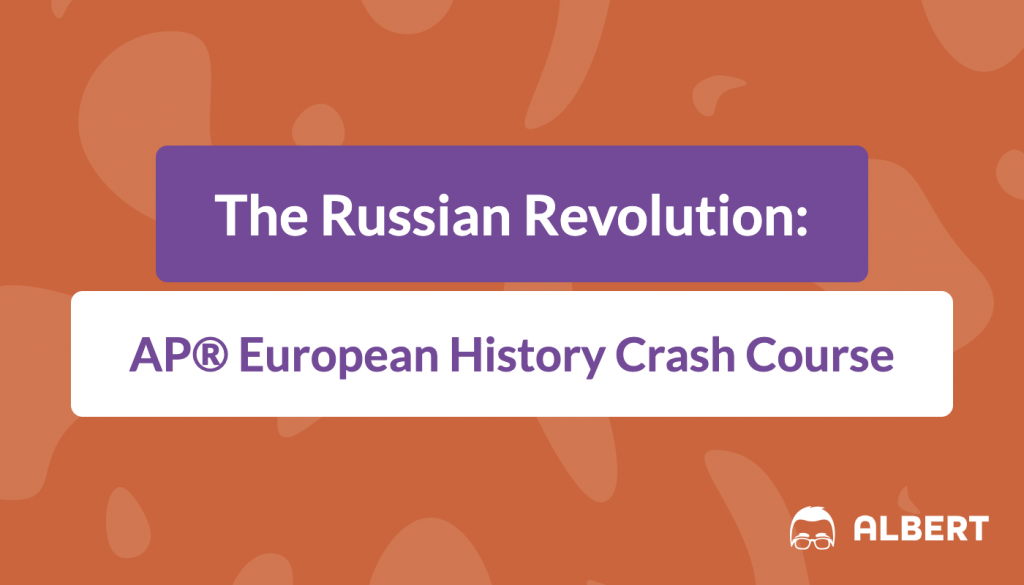Note: This article was released prior to the 2015-2016 revision to the AP® European History exam. In order to see what is still in the Course and Exam Description, explore the course framework here.
This AP® European History crash course, covering the Russian Revolution of the early 20th century, will briefly introduce you to the concept and how it will relate to the AP® European History exam, as well as explain the background, the conflict, and the effects of this seminal moment in the development of European and, on a grander scale, World history.
Continue reading for an overview of the Russian Revolution. This crash course should be a good place for you to start your AP® European History review.
The Russian Revolution: what is it?

First off, the “Russian Revolution” is a little bit of a misnomer. Strictly speaking, the first revolution, starting in 1905 and ending in the summer of 1907, was the beginning of the entire Russian Revolution. True to form, the Russian Revolution of 1905 was the result of a confluence of major issues that, considered separately, were not at all insurmountable by the people of Russia. However, when the problems of poor agriculture, nationality, labor, and education descended in concert on Russian society, revolution was necessitated.
Again, true to form, the revolution of 1905 resulted in the Russian Constitution of 1906. This constitution and the resulting empire did not last. In truth, both were doomed from their mutual start. By late 1917, Vladimir Lenin and the Bolsheviks, in a peaceful manner, formed the first Marxist state that the world had seen.
The first stage of the Russian Revolution of 1917, which eventually resulted in the installation of the Marxist government, began in February of the Julian calendar (the Russian calendar at the time), March on the Gregorian calendar. This is known as the February Revolution due to the peculiar calendar situation. Growing civil unrest due in part to dissatisfaction with the imperial system and Czar Nicholas II, combined with persistent food shortages, resulted in the establishment of a provisional government and the abdication of the Czar.
The citizenry of Russia was in upheaval by 1917. Czar Nicholas II frequently dissolved parliament whenever it disagreed with him. Corruption in the government was flagrant and growing. Russia’s economy was impotent at best. However, the true, cardinal cause of the revolution was Russia’s devastating involvement in World War I. Russia had sustained disastrous losses; Rough estimates of total casualties hover between 2.8 million and 3.3 million. About a quarter of the lives lost in WWI were Russian.
The war effort was costly, both monetarily and spiritually. The Russian economy was in flux. Citizens could not afford not to act again. These circumstances led to the October Revolution, the second stage of the Russian Revolution of 1917, on November 6th and 7th (due to the Julian/Gregorian calendar issue). The Bolshevik Revolution, the October Revolution, resulted in the installation of Lenin and the beginning of the Marxist state.
The Russian Revolution: the sequence of events
March 8th, 1917: Protesters take to the streets of Petrograd (now St. Petersburg) over food shortages and clash with police.
March 10th, 1917: The strike spreads to the workers of Petrograd, and the Petrograd Soviet (council) of workers is formed.
March 11th, 1917: Russian soldiers are called in; some protesters are killed.
March 12th, 1917: The revolutionaries succeed when Russian soldiers defect to the cause of the revolution.
March 14th, 1917: The Petrograd Soviet issues its first order, which instructed soldiers to obey only those orders that come from the Soviet.
March 15th, 1917: Czar Nicholas II abdicates the throne; his brother, Michael, refused the crown, resulting in the fall of the czarist autocracy.
March-October 1917: The provisional government appointed by the Duma (parliament) and the Petrograd Soviet share power. However, more radical, leftist parties were not pleased by their governance.
November 6th and 7th, 1917: Vladimir Lenin and the Bolshevik party launch the Bolshevik Revolution, a near bloodless coup that resulted in the installation of Lenin as the new head of the government.
1918-1920: Russia experiences civil war between Bolsheviks and the White Army (anti-Bolsheviks). The Bolsheviks defeated the White Army forces.
1922: The Union of Soviet Socialist Republics (USSR) is established.
The Russian Revolution on the AP® European History Exam

The AP® European History exam has undergone a redesign that limits the scope of the knowledge test-takers are expected to possess concerning any given event or concept that will appear on the AP® European History exam. Luckily, it’s relatively easy to define the core principles that the College Board expects you to know when preparing for the AP® Euro test.
Continue reading for an overview of these concepts.
Pre-Revolution Social Classes
Nobles: The Nobles made up the majority of the government pre-Russian Revolution. They held the majority of power from the 12th century until the revolution and largely wished to keep it that way through the revolutions.
Middle Class: Up until the revolution, there actually was little opportunity for the educated middle class in Russia. Most of Russian economic activity was centered on military production, leaving no prospects really for the middle class.
Workers: The Russian working class was made up of the factory, mine, and production workers. They were disillusioned with their inability to gain a legitimate voice in government by 1917.
Peasants: The peasantry had no voice in representation. They were poor and their needs were subordinated by the needs of the war effort. As the majority of the population, the cost of the war became a great problem for them.
Pre-Revolution Political Parties
You will need to also understand how these social classes identified themselves politically. You can find information on the most important political parties for you to study in preparation for the AP® Euro exam, Nationalists, Octobrists, Constitutional Democrats, Socialist Revolutionaries, Mensheviks, and Bolsheviks, here.
The February Revolution
This concept is discussed above, but, in short, this was the first stage of the Russian Revolution of 1917.
The Provisional Government
Made up of the remainder of the Duma, the parliament, and the Petrograd Soviet, this government lasted only a few months in 1917 before the Bolshevik Revolution.
Lenin’s April Theses
Lenin’s April Theses were issued on April 4th, 1917, a month after the February Revolution. You can find them here.
The October Revolution
This concept, like the February Revolution, is discussed above. In summation, this was the second and final stage of the Russian Revolution of 1917.
The Civil War
The civil war between the ruling Bolsheviks and the anti-Bolshevik White Army took place between 1918 and 1920, as discussed above.
The Russian Revolution—The Bottom Line
The bottom line for your AP® European History review, insofar as the Russian Revolution relates to it, should be that the Russian Revolution mirrors many other revolutionary time periods that you’ve studied in AP® European History.
We recommend having, at the very least, a solid understanding of how this revolution relates to others that you’ve studied. What’s different about this revolution? What is the same?

